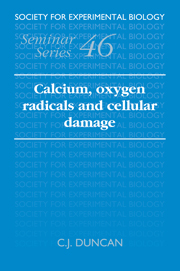Book contents
- Frontmatter
- Contents
- List of Contributors
- Preface
- 1 Are there common biochemical pathways in cell damage and cell death?
- 2 Free radicals in the pathogenesis of tissue damage
- 3 Calcium and signal transduction in oxidative cell damage
- 4 Regulation of neutrophil oxidant production
- 5 Reperfusion arrhythmias: role of oxidant stress
- 6 Biochemical pathways that lead to the release of cytosolic proteins in the perfused rat heart
- 7 Malignant hyperthermia: the roles of free radicals and calcium?
- 8 Free radicals, calcium and damage in dystrophic and normal skeletal muscle
- 9 Ultrastructural changes in mitochondria during rapid damage triggered by calcium
- 10 The importance of oxygen free radicals, iron and calcium in renal ischaemia
- 11 The Rubicon Hypothesis: a quantal framework for understanding the molecular pathway of cell activation and injury
- Index
8 - Free radicals, calcium and damage in dystrophic and normal skeletal muscle
Published online by Cambridge University Press: 18 January 2010
- Frontmatter
- Contents
- List of Contributors
- Preface
- 1 Are there common biochemical pathways in cell damage and cell death?
- 2 Free radicals in the pathogenesis of tissue damage
- 3 Calcium and signal transduction in oxidative cell damage
- 4 Regulation of neutrophil oxidant production
- 5 Reperfusion arrhythmias: role of oxidant stress
- 6 Biochemical pathways that lead to the release of cytosolic proteins in the perfused rat heart
- 7 Malignant hyperthermia: the roles of free radicals and calcium?
- 8 Free radicals, calcium and damage in dystrophic and normal skeletal muscle
- 9 Ultrastructural changes in mitochondria during rapid damage triggered by calcium
- 10 The importance of oxygen free radicals, iron and calcium in renal ischaemia
- 11 The Rubicon Hypothesis: a quantal framework for understanding the molecular pathway of cell activation and injury
- Index
Summary
Introduction
Skeletal muscles are subjected to considerable physical stresses during normal contractile activity, and during excessive or unaccustomed exercise may become seriously damaged such that normal contractile function is impaired. This is evidenced by morphological and ultrastructural changes in muscle together with leakage of large intracellular components (such as certain cytosolic enzymes) into the extracellular fluid. Analogous changes appear to occur in various disease states such as the muscular dystrophies, malignant hyperthermia and various inflammatory myopathies.
In man, muscle damage can be conveniently monitored by measurement of the activity of various muscle-derived enzymes in the blood. The most commonly used of these are creatine kinase or aldolase with creatine kinase determination being particularly useful because of its high sensitivity and because analysis of the isoform pattern of the MM type allows an examination of the elapsed time since the occurrence of an episode of muscle damage leading to enzyme efflux (Page et al., 1989). Further evidence for, or confirmation of, the occurrence of damage can readily be obtained by percutaneous biopsy of the affected muscle under local anaesthetic (Edwards, MacLennan & Jackson, 1989) followed by histological or electron microscopic examination of the tissue. Studies designed to elucidate the mechanisms by which skeletal muscle damage occurs following exercise or in disease states are rare in comparison to studies of the heart or other organs, but a number have been undertaken using different systems. Many of the human studies have (of necessity) been non-invasive and descriptive from which little information concerning basic mechanisms can be obtained, but many further data have been obtained from experiments with animal models in vivo and from in vitro studies of isolated skeletal muscle tissue.
- Type
- Chapter
- Information
- Calcium, Oxygen Radicals and Cellular Damage , pp. 139 - 148Publisher: Cambridge University PressPrint publication year: 1991
- 1
- Cited by



